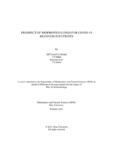Prospect of bioprinted lungs for COVID-19 recovered patients
Abstract
Ever since its first case detected in December 2019 in Wuhan, the Covid-19 infection caused
by the SARS-CoV-2 strain of the coronavirus, it has gone on to affect a total of 71,516,809
(last recorded on 12th December,2020) people all over the world. This resulted in the biggest
pandemic since 1920 and caused over 16,03,054 deaths at a rate of approximately 3%.
One of the vital ORGANS of attack for the virus in humans is the lungs which is involved in
arguably the most important function of the human body, respiration. Study showed that around
90% of the lungs get infected by the virus. While, majority of the population below the age
group of 50 were successful in fighting off the infection, the virus tends to leave a lasting effect
that leads to detrimental effects.
The purpose of this research is to integrate tissue engineering and bioprinting and look at
Bioprinted lungs through transplantation as a viable alternative to treat lung infections.
Furthermore, it underlines the functioning of the lungs and the parts which can be engineered
to create artificial lungs, in order to initiate a successful transplantation. To add with it, the
motive of this study is also to compare how a Bioprinted organ transplantation is much viable
and provides less health complications than a normal transplantation.

